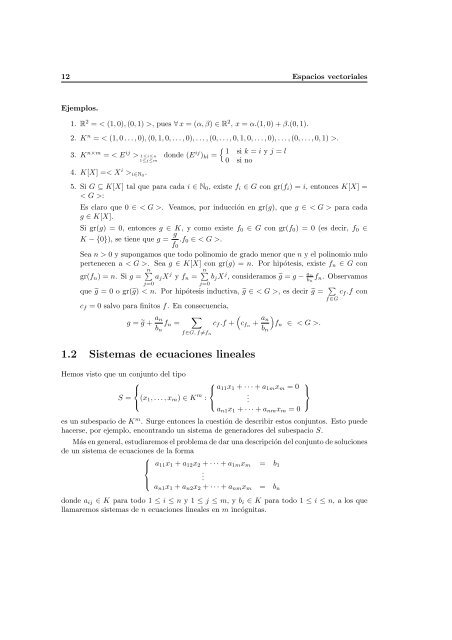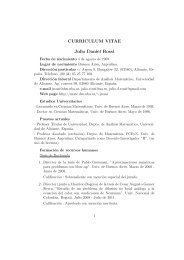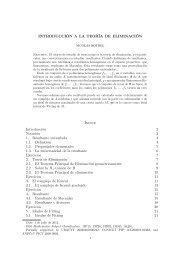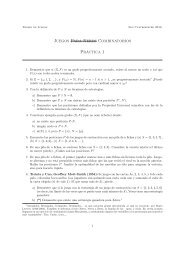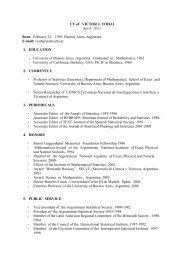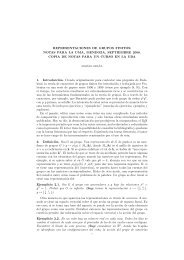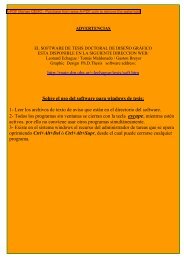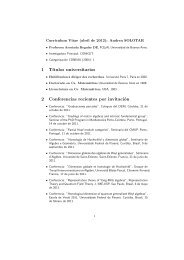´Algebra lineal - Universidad de Buenos Aires
´Algebra lineal - Universidad de Buenos Aires
´Algebra lineal - Universidad de Buenos Aires
You also want an ePaper? Increase the reach of your titles
YUMPU automatically turns print PDFs into web optimized ePapers that Google loves.
12 Espacios vectoriales<br />
Ejemplos.<br />
1. R 2 = < (1, 0), (0, 1) >, pues ∀ x = (α, β) ∈ R 2 , x = α.(1, 0) + β.(0, 1).<br />
2. Kn = < (1, 0 . . . , 0), (0, 1, 0, . . . , 0), . . . , (0, . . . , 0, 1, 0, . . . , 0), . . . , (0, . . . , 0, 1) >.<br />
3. Kn×m = < Eij > 1≤i≤n<br />
1≤j≤m<br />
don<strong>de</strong> (Eij <br />
1<br />
)kl =<br />
0<br />
si k = i y j = l<br />
si no<br />
4. K[X] =< X i >i∈N0.<br />
5. Si G ⊆ K[X] tal que para cada i ∈ N0, existe fi ∈ G con gr(fi) = i, entonces K[X] =<br />
< G >:<br />
Es claro que 0 ∈ < G >. Veamos, por inducción en gr(g), que g ∈ < G > para cada<br />
g ∈ K[X].<br />
Si gr(g) = 0, entonces g ∈ K, y como existe f0 ∈ G con gr(f0) = 0 (es <strong>de</strong>cir, f0 ∈<br />
K − {0}), se tiene que g = g<br />
.f0 ∈ < G >.<br />
f0<br />
Sea n > 0 y supongamos que todo polinomio <strong>de</strong> grado menor que n y el polinomio nulo<br />
pertenecen a < G >. Sea g ∈ K[X] con gr(g) = n. Por hipótesis, existe fn ∈ G con<br />
gr(fn) = n. Si g = n<br />
ajX j y fn = n<br />
bjX j , consi<strong>de</strong>ramos g = g − an<br />
bn fn. Observamos<br />
j=0<br />
j=0<br />
que g = 0 o gr(g) < n. Por hipótesis inductiva, g ∈ < G >, es <strong>de</strong>cir g = <br />
cf = 0 salvo para finitos f. En consecuencia,<br />
g = g + an<br />
fn =<br />
<br />
cf .f +<br />
bn<br />
f∈G, f=fn<br />
1.2 Sistemas <strong>de</strong> ecuaciones <strong>lineal</strong>es<br />
cfn<br />
<br />
an<br />
+ fn ∈ < G >.<br />
bn<br />
Hemos visto que un conjunto <strong>de</strong>l tipo<br />
⎧<br />
⎨<br />
S =<br />
⎩ (x1, . . . , xm) ∈ K m ⎧<br />
⎫<br />
⎨ a11x1 + · · · + a1mxm = 0 ⎬<br />
:<br />
.<br />
⎩ .<br />
⎭<br />
an1x1 + · · · + anmxm = 0<br />
f∈G<br />
cf .f con<br />
es un subespacio <strong>de</strong> K m . Surge entonces la cuestión <strong>de</strong> <strong>de</strong>scribir estos conjuntos. Esto pue<strong>de</strong><br />
hacerse, por ejemplo, encontrando un sistema <strong>de</strong> generadores <strong>de</strong>l subespacio S.<br />
Más en general, estudiaremos el problema <strong>de</strong> dar una <strong>de</strong>scripción <strong>de</strong>l conjunto <strong>de</strong> soluciones<br />
<strong>de</strong> un sistema <strong>de</strong> ecuaciones <strong>de</strong> la forma<br />
⎧<br />
⎪⎨<br />
⎪⎩<br />
a11x1 + a12x2 + · · · + a1mxm = b1<br />
.<br />
.<br />
an1x1 + an2x2 + · · · + anmxm = bn<br />
don<strong>de</strong> aij ∈ K para todo 1 ≤ i ≤ n y 1 ≤ j ≤ m, y bi ∈ K para todo 1 ≤ i ≤ n, a los que<br />
llamaremos sistemas <strong>de</strong> n ecuaciones <strong>lineal</strong>es en m incógnitas.


